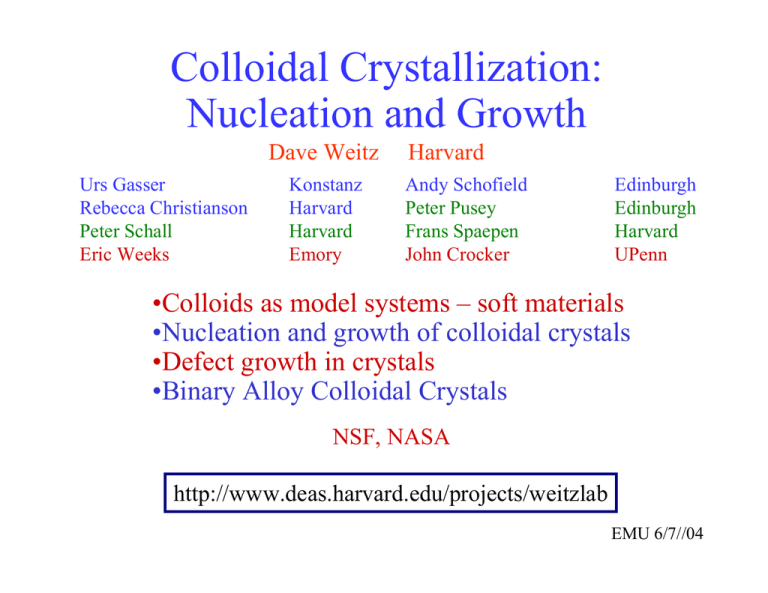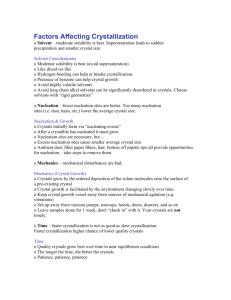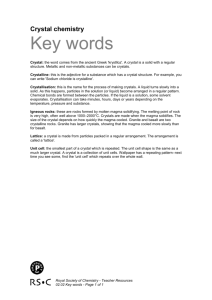Colloidal Crystallization: Nucleation and Growth •Colloids as model systems – soft materials
advertisement

Colloidal Crystallization: Nucleation and Growth Dave Weitz Urs Gasser Rebecca Christianson Peter Schall Eric Weeks Konstanz Harvard Harvard Emory Harvard Andy Schofield Peter Pusey Frans Spaepen John Crocker Edinburgh Edinburgh Harvard UPenn •Colloids as model systems – soft materials •Nucleation and growth of colloidal crystals •Defect growth in crystals •Binary Alloy Colloidal Crystals NSF, NASA http://www.deas.harvard.edu/projects/weitzlab EMU 6/7//04 Colloidal Crystals Colloids 1 nm - 10 µm solid particles in a solvent Ubiquitous ink, paint, milk, butter, mayonnaise, toothpaste, blood Suspensions can act like both liquid and solid Modify flow properties Control: Size, uniformity, interactions Colloidal Particles •Solid particles in fluid •Hard Spheres •Volume exclusion •Stability: •Short range repulsion •Sometimes a slight charge Colloid Particles are: •Big Slow •~ a ~ 1 micron •Can “see” them • τ ~ a2/D ~ ms to sec •Follow individual particle dynamics Model: Colloid Æ Atom Phase Behavior Colloids Atomic Liquids U U s Hard Spheres Osmotic Pressure Centro-symmetric Thermalized: kBT Gas Liquid Density Solid s Leonard-Jones Attraction Centro-symmetric Thermalized: kBT Gas Liquid Solid Phase behavior is similar Hard Sphere Phase Diagram Volume Fraction Controls Phase Behavior liquid liquid - crystal coexistence 49% 54% maximum packing φRCP≈0.63 crystal 63% 74% φ maximum packing φHCP=0.74 Increase φ => Decrease Temperature 0 F = U - TS Entropy Drives Crystallization Entropy => Free Volume 0 F = U - TS Disordered: •Higher configurational entropy •Lower local entropy •Higher Energy Ordered: •Lower configurational entropy •Higher local entropy •Lower Energy maximum packing φRCP≈0.63 maximum packing φHCP=0.74 Soft Solids Easily deformable Æ Low Elastic Constant: Atoms: eV 3 Α ~GPa Colloids: kBT µ m3 ~Pa Energy Volume Easily deformed Æ Shear melt to randomize Colloidal Particle Æ Atom Watch each atom! Confocal Microscopy Regular Confocal detector lens objective in focus out of focus pinhole Confocal microscopy for 3D pictures 0.2 µm Scan many slices, reconstruct 3D image Microscopy and Tracking Confocal microscopy: Particle tracking: •30 images/s (512×480 pixels, 2D) •one 3D “cube” per 6 s •67 × 63 ×10 µm3 •100× oil / 1.4 N.A. objective •Identify particles within 0.03 µm (xy) 0.05 µm (z) •Follow 3000-5000 particles, in 3D •200-1000 time steps = hours to days •≈ 4 GB of images per experiment First direct 3D observation of dynamics Brownian Motion in Real Time Colloidal Crystals 1 cm 25 µm Bragg scattering of visible light Hexagonal close-packed layers (FCC/HCP) Nucleation and Growth of Colloidal Crystals 2.3 µm diameter PMMA spheres Questions: •How do crystals nucleate? •What is structure of pre- and post-critical nuclei? •How does structure evolve with time? •What is free energy barrier? Crystallization ∆G = γ ( 4π r 2 ) − ∆µ ( Surface energy 4 3 πr 3 ) Chemical potential ∆G r How to Identify Crystals 2.3 µm diameter PMMA spheres Must identify incipient crystal nuclei Voronoi polyhedra -Delaunay triangulation (“Wigner-Seitz cell”) defines nearest neighbor particles Local Crystallization Order Parameter P. R. ten Wolde, M. J. Ruiz-Montero, D. Frenkel: J. Chem. Phys. 104, 9932 (1996) •Find nearest neighbor connections rij •Resolve connections in spherical harmonics: qlm(i)=⟨Ylm(rij)⟩j •Examine l=6 •Define Order Parameter: q6m(i) · q6m(j) •If q6m(i) · q6m(j) > 0.5, then bond (ij) is “crystal-like” •if particle has ≥ 8 “crystal-like” bonds, it is a crystal-like particle Colloidal Crystallization Determination of Size of Critical Nucleus Crystal Nucleus Structure R ~ Rc φ = 0.47 Structure of Crystal Nucleus φ bcc fcc hcp liquid 0.49 0.00(3) 0.10(3) 0.32(6) 0.58(1) 0.45 0.00(1) 0.58(7) 0.20(3) 0.22(6) 0.43 0.00(3) 0.34(5) 0.25(4) 0.41(1) RHCP: Random Hexagonally Close Packed A B C A fcc hcp Nucleation Rate Comparable to light scattering measurements Faster than simulations Finding Surface Tension ∆G = γ ( 4π r 2 ) − ∆µ ( Surface energy 4 3 πr 3 ) Chemical potential ⎛ − ∆G ⎞ 2 ⎟⎟ ≈ exp − γr P(r ) ≈ exp⎜⎜ ⎝ k BT ⎠ ( (for small r) ) Measurement of Surface Tension 1000 γ (kT/a2) 0.02 100 0.016 N 0.012 0.4 0.45 0.5 0.55 0.6 Φ 10 1 0 100 200 300 400 500 600 700 800 2 A (µm ) Surface tension is very low 900 1000 Depletion Zone near Surface φ ( shell )-<φ > / < φ > 0.04 φ=0.373 φ=0.428 0.03 φ=0.492 crystal liquid 0.02 0.01 0.00 -0.01 1 2 3 4 shell 5 6 Crystal Structure through Interface 0.8 (crystal) cx (fluid) 0.4 bcc fcc hcp fluid 0.0 1 3 5 7 shell No bcc structure at all Random stacking of hexagonal planes Fractal Structure of Growing Crystallites 103 3.0 df 2.5 2.0 1.5 M 102 1.0 0.4 Φ 0.5 0.6 101 100 100 101 rg (µm) Single Crystal Growth - Principle Peter Schall and Frans Spaepen Laser mask writer A B A (a) Fixed stacking sequence (b) fcc single crystal Templated Growth of Single Crystals SEM micrograph Confocal micrograph Thin Film of Single Crystal Colloidal crystals diffracted beams transmitted beam Imaging Dislocations : Laser Microscope Colloidal Crystal Screen Lens Objective Imaging Dislocations: Excitation Error Exact two beam condition Transmitted beam Diffracted beam Two beam with excitation error Transmitted beam Diffracted beam Imaging Dislocations: Nearly perfect crystal 0 Exact two beam condition Two beam with excitation error 0 100 µm “good“ lattice constant Imaging Dislocations Exact two beam condition Two beam with excitation error 100 µm Template stretched by 1.5 % Nucleation and Growth of Dislocations • template lattice constant off by 1.5 % (film recorded immediately after settling of ~ 8 additional crystalline layers recording time 3.5 hours Stacking Faults induced by Lattice Mismatch Growth of Defects A B t=t0 t=t0+16 min C t=t0+260 min 11 44 22 33 100 µm 100 60 2 1 3 40 4 FPK Ffr Fl screw edge 20 80 L [µm] L [µm] 80 1 60 40 20 0 0 20 40 60 80 100 120 140 160 t [min] 0 0 •Balance forces for growth rate •Elastic force = viscous drag + line tension •Exponential functional form 500 1000 1500 t [sec] Indentation experiment sewing needle tip (Crystal at the end of the movie; there is still a couple of layers above the layers shown) Dislocation Dynamics and Interactions • Indentation 100 µm Binary Colloidal Crystals Maximum Volume Fraction 0.8 (Schofield, et al) AB6 BCC AB (CsCl) AB2 AB6 SC 0.6 AB13 AB (NaCl) 0.0 0.2 0.4 0.6 RB/RA 0.8 1.0 AB6 • AB6 occurs in three different structures: simple cubic, BCC and FCC, which occur at different size ratios from 0.3 to 0.4 • BCC is the fastest to crystallize, with crystals forming overnight at the optimal size ratio of 0.4 AB6 Binary Alloy Crystal • Very intense Bragg scattering • Very large crystals AB6 Binary Alloy Crystal •Very well ordered FCC structure •Small particles induce effective long-range intereaction •Creates highly ordered large particle lattice Nucleation and Growth of AB6 Look only at large particles Æ perfect BCC lattice AB13 • Icosahedra of small particles, at center of simple cube of big particles • Found naturally in bimetallic alloys such as NaZn13 • Stable at size ratios from 0.5-0.7 10000 0.000 0.005 0.010 (6 0 0) (6 2 2) (6 4 2) (7 3 1) (8 2 0) (8 2 2) (7 5 3) (5 3 1) AB13 SLS Spectrum Red indicates superlattice (6 2 0) (4 4 4) (6 4 0) (8 0 0) (7 5 1) 100000 (4 4 0) ? Intensity (2 2 2) (4 0 0) 1000000 (4 2 2) (4 2 0) (2 2 0) (2 0 0) AB13 Space Sample RB/RA = 0.57, NB/NA = 19 0.015 0.020 Q (1/nm) 0.025 0.030 0.035 0.040 Mixed Sizes: AB13 Binary Alloy Crystal •Very well ordered FCC structure •Small particles induce effective long-range intereaction •Creates highly ordered large particle lattice Conclusions Real space imaging of colloidal structure and dynamics •3D observation of crystallization •Defect growth in crystal films •Binary Alloy Colloidal Crystals http://www.deas.harvard.edu/projects/weitzlab






